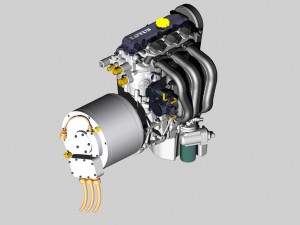
Lotus will show off a high-tech powertrain, rather than a new model, at the 2009 Frankfurt Motor Show, an extended-range electric vehicle package.
While most automakers will be shining the spotlight on their latest sheet metal, Lotus Engineering will put the focus on the iron and aluminum underneath during its news conference at the 2009 Frankfurt Motor Show, next week.
The company, the consulting and engineering arm of Lotus Cars, has provided us with this sneak peek at its new Range-Extended engine, a serial hybrid system similar to what will debut inside the Chevrolet Volt, in November 2010.
The concept would permit a manufacturer using the EREV (for Extended-Range Electric Vehicle) technology to blend what are arguably the best assets of an electric vehicle and a more conventional hybrid-electric; an EREV, like Volt, can initially be driven solely on electric power and then, when its batteries run down, the system switches to a small internal combustion engine.
As with Volt, the Lotus EREV uses its aluminum, 3-cylinder, 1.2-liter gas engine solely as a generator. When it fires up, it can send current to the system’s 47 horsepower electric motor, or it can be used to recharge the battery pack.
Specific performance details would depend on such factors as the size, weight and aerodynamics of the vehicle and the size and type of batteries used – Chevy, for example, uses a T-shaped package of Lithium-Ion cells to yield about 40 miles on battery power alone.
The downsized engine Lotus is using relies on a compact, 2-valve port-injection combustion system to hold down both size and mass, the entire powertrain – minus batteries – weighing in at just 123 pounds. The battery pack, however, could run anywhere from five to ten times as much, depending on the target vehicle and necessary electric-only range. But Lotus engineers contend that by minimizing the rest of the powertrain, the entire vehicle, including batteries, can be downsized.
While Lotus isn’t saying, the modest numbers suggest the EREV package is geared for a vehicle in the subcompact or minicar segment.
Automotive officials are quick to suggest that there are “no silver bullets” when it comes to resolving the twinned issues of fuel economy and emissions. Automakers are looking at everything from “mild” hybrids to hydrogen fuel cells. Variations of the hybrid-electric concept are gaining momentum in much of the world, though so far, manufacturers have been relying on parallel hybrids to power vehicles like the Toyota Prius, Honda Insight and Ford Fusion Hybrid.
With parallel technology, both an electric motor and a gasoline (or diesel) engine are both connected to the driveline, and either can be used to spin the wheels. Serial hybrids use electric propulsion alone, which is why vehicles like the Volt, as well as the Lotus drivetrain, are referred to as Extended-Range Electrics.
While Volt has gotten the lion’s share of publicity, a number of other makers are developing EREVs, including Toyota, which will put a version of its Prius into limited production in the coming year.
